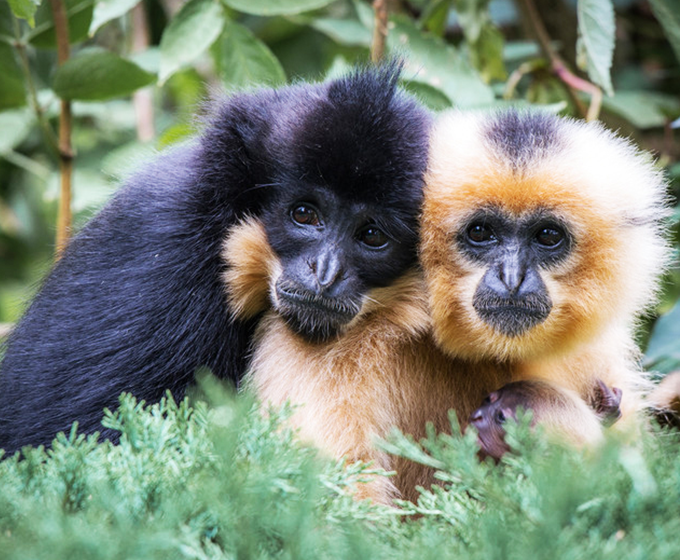
JANUARY 29, 2020 — A UTSA researcher has discovered that, whether in a pair or in groups, success in primate social systems may also provide insight into organization of human social life.
Assistant professor Luca Pozzi in UTSA’s Department of Anthropology in collaboration with Peter Kappeler, a colleague at the German Primate Center-Leibniz Institute for Primate Research, investigated how different primate societies evolved and which factors may be responsible for transitions among them.
Their reconstructions showed that the evolution from a solitary way of life to group living usually occurred via pair living. Pair living thus served as a stepping stone for group living and therefore plays a key role in the evolution of social systems.
—LUCA POZZI, Assistant Professor in UTSA's Department of Anthropology
In the course of evolution, species had to adapt to changing environmental conditions, according to Pozzi. A crucial adaptation in this process is the modification of social behavior. About half of all primate species live in groups and around one third in pairs; the rest live solitarily.
Why these different forms of social complexity evolved, how many transitions among them occurred and which factors led to the transitions was analyzed on the basis of genetic data and behavioral observations of 362 primate species.
“Living as a pair represents an evolutionary puzzle in the evolution of mammalian social systems because males could achieve higher rates of reproduction if they did not bond to a single female,” says Pozzi.
Yet evolutionary biologists still struggle to find the advantages of pair living for males, according to Peter Kappeler, who is one of the lead researchers of the study.
At first glance the two current hypotheses on the development of pair living—the female distribution hypothesis and the paternal care hypothesis—seem to be mutually exclusive.
Yet results in this work indicate that the two factors may be complementary. Initially it was believed that an ecological change in the habitat led to female spatial separation and that solitary males, which previously had several females living in their territory, were subsequently only able to gain access to one female. Paternal care resulting from the pair formation in turn increased the survival probability of the offspring and thus reinforced pair living.
The further transition to group living was possible through an improvement of the ecological situation, which allowed related females to live in close proximity. These could then be joined by one or more males.
“However, the pair bond typical for humans within larger social units cannot be explained with our results, since none of our recent ancestors lived solitarily. Nevertheless, the advantages of paternal care also may have led to a consolidation of pair living in humans,” said Kappeler.
The research, “Evolutionary transitions towards pair living in non-human primates as stepping stones towards more complex societies,” was published in the December issue of Science Advances.
“The evolution of complex social systems in mammals, and more specifically in primates, is a challenging and exciting area of research. Our study shows that pair living—although rare—might have played a critical role in it,” says Pozzi
Connect with UTSA online at Facebook, Twitter, YouTube, Instagram and LinkedIn.
UTSA Today is produced by University Communications and Marketing, the official news source of The University of Texas at San Antonio. Send your feedback to news@utsa.edu. Keep up-to-date on UTSA news by visiting UTSA Today. Connect with UTSA online at Facebook, Twitter, Youtube and Instagram.
After getting your student settled in their room, connect with other UTSA families at our Family Get Together. Attendees need to RSVP for the event.
Rock & Brews Restaurant - 5702 Landmark Pkwy, San Antonio, TX 78249Late Night at the Rec is an awesome UTSA tradition that turns a typical information session into an exciting night of fun. It's a unique opportunity to meet new people and reconnect with old friends.
Campus RecreationCheer on the UTSA Soccer team as they take on Lamar in the first home game of the season.
Park West FieldShow your UTSA pride with our spirited crew—Rowdy, Cheer, the Spirits of the Roadrunner, and the incredible Spirit of San Antonio Marching Band (SOSA)—as we light up the night in true Roadrunner style.
Main Campus East Lawn, Main CampusAnnual Giving will host a First Day of School celebration to welcome students back to campus. We will have giveaways and photo opportunities.
Sombrilla Plaza, Main CampusEnjoy snacks while connecting with Adobe reps and student ambassadors. Download or log into the Adobe Express app to snag swag and unlock exclusive back-to-school templates. It’s a fun, fast way to get creative and start the school year with bold moves.
Central Plaza, Main CampusCelebrate the merger of UTSA and UT Health San Antonio with a pop-up featuring free t-shirts, exclusive swag, and interactive photo opportunities. Open to all students, faculty and staff. Supplies are limited!
Sombrilla Plaza, Main CampusThe University of Texas at San Antonio is dedicated to the advancement of knowledge through research and discovery, teaching and learning, community engagement and public service. As an institution of access and excellence, UTSA embraces multicultural traditions and serves as a center for intellectual and creative resources as well as a catalyst for socioeconomic development and the commercialization of intellectual property - for Texas, the nation and the world.
To be a premier public research university, providing access to educational excellence and preparing citizen leaders for the global environment.
We encourage an environment of dialogue and discovery, where integrity, excellence, respect, collaboration and innovation are fostered.